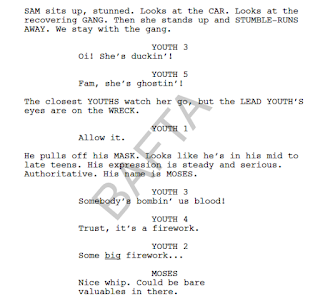SCRIPT FINAL DRAFT
(Wednesday 30th November)
 |
| Dialect in Attack the Block (2011) |
For the final
draft of my script, I have had to massively cut down my words, resulting in
losing 2 pages off my total. I also had to lose quite a lot of dialogue to make
room for my new ending and an added scene, but this wasn’t too difficult, because when
it came down it I could easily see that with my new storyline a lot of old dialogue was no longer necessary.
I have also
included a small new scene with an innocent bystander, explaining the
unexpected arrival of the police and paramedics to the scene. Also, I have worked on formatting my capitalising important of impactful words in my directions.
Finally, I
did some research into accent and dialogue in screenplays, including the final
script for Attack the Block (2011). Although this dialect is very different from the
one I have tried to portray for Adam, this still helped me examine how they are
written for film and TV, assisting me with my work.
















